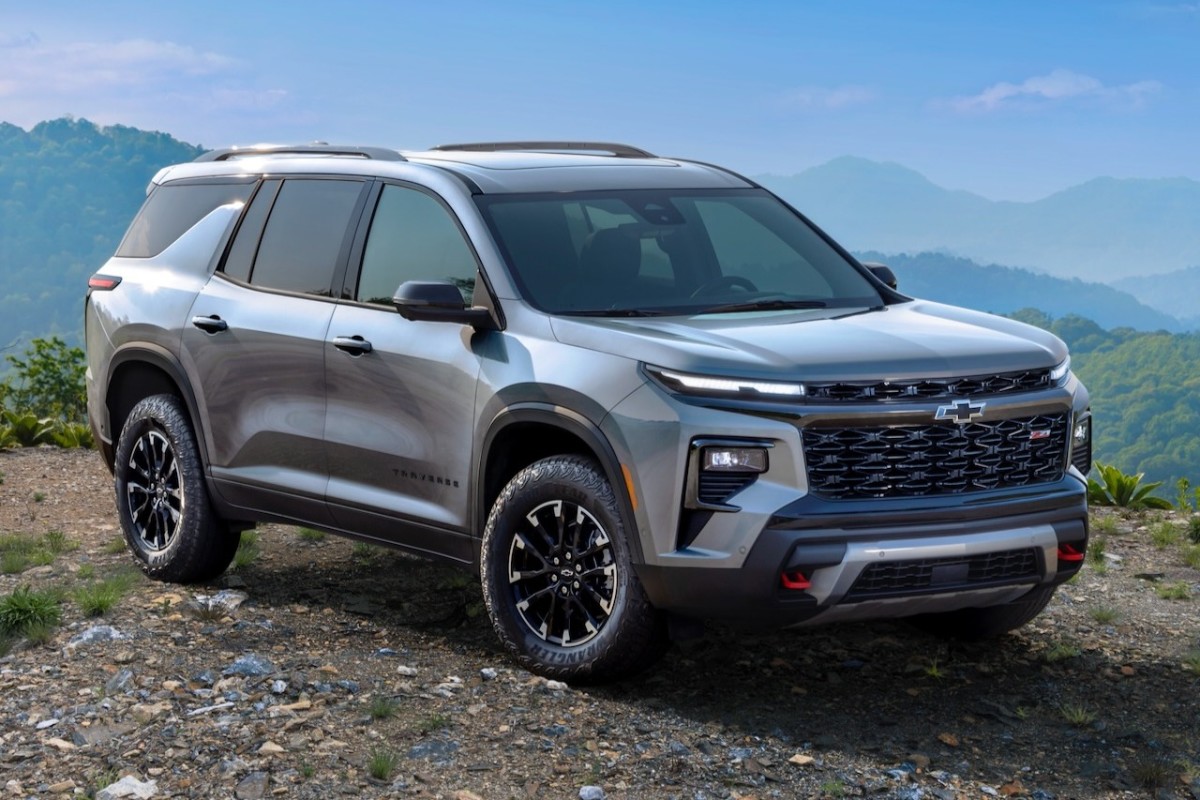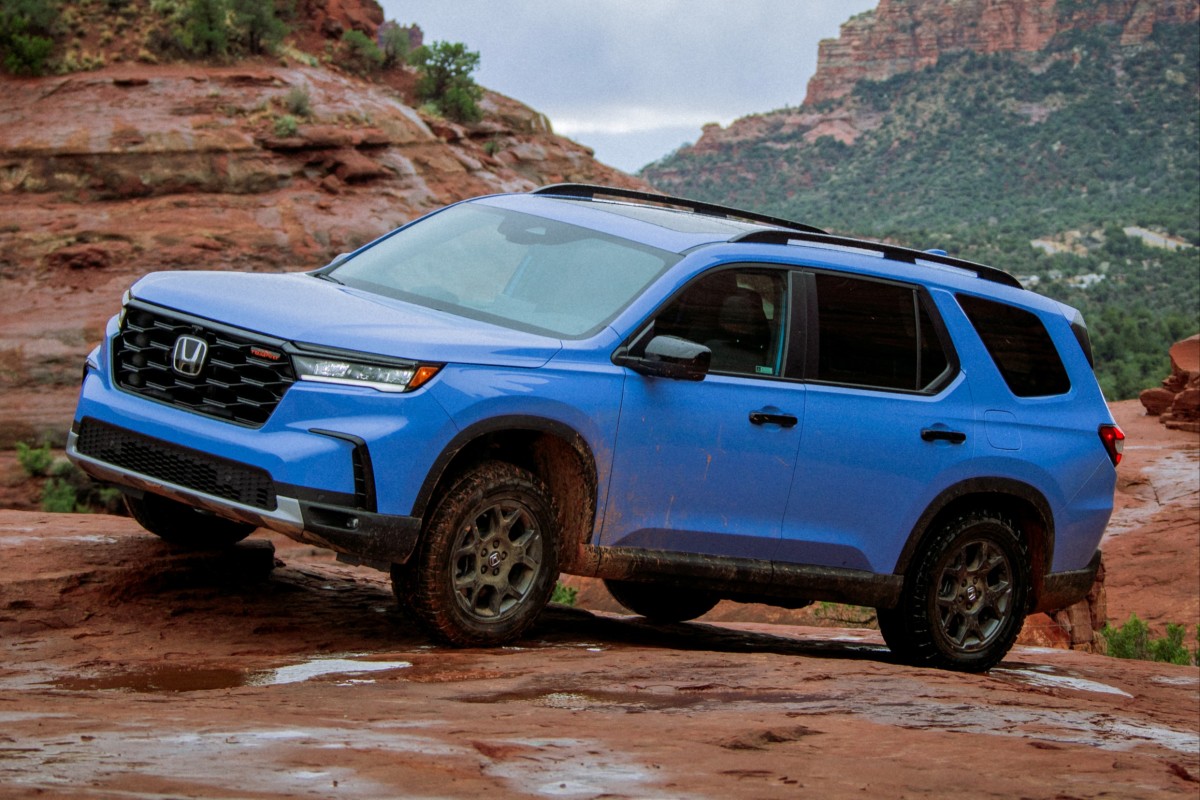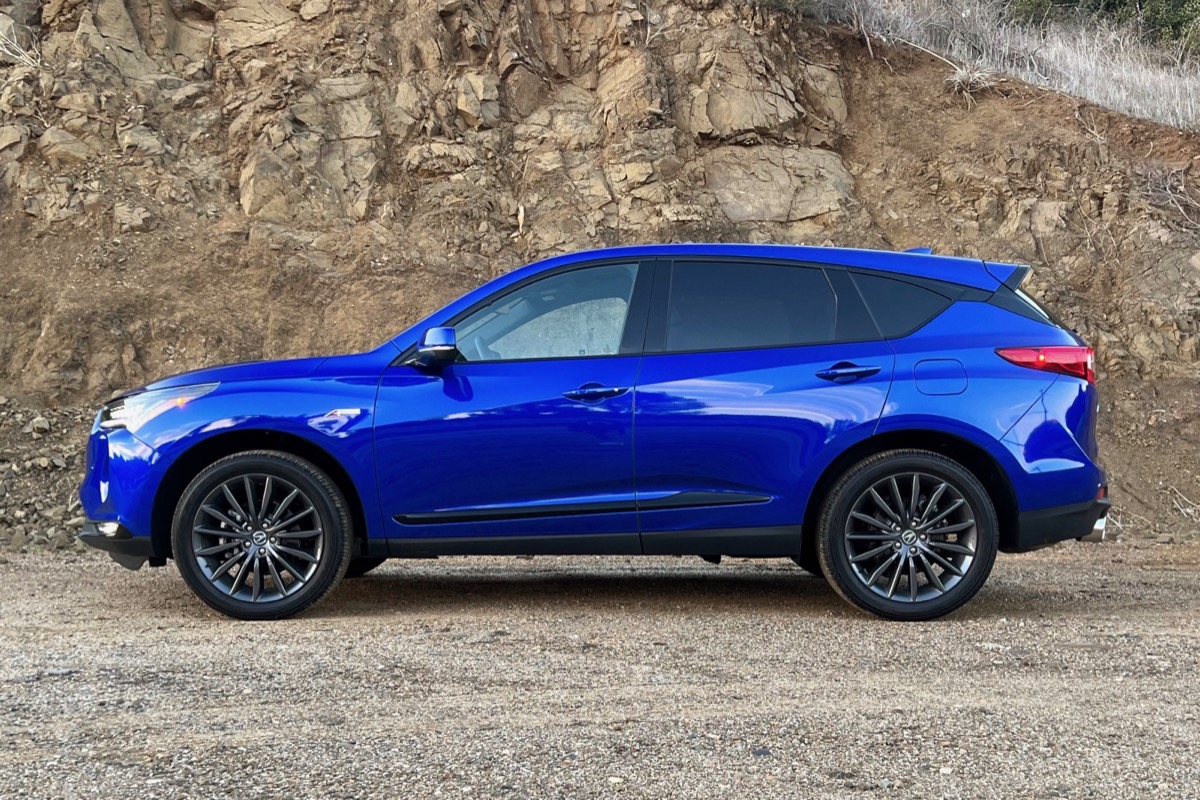The Chevrolet Traverse is the Bowtie brand’s biggest crossover and, in fact, one of the largest crossover SUVs on the market, sitting above the Equinox and the Blazer SUVs. Though often thrown in with midsize three-row competitors such as the Kia Telluride, the Subaru Ascent, the Volkswagen Atlas, and the Honda Pilot, the Traverse is actually quite a bit bigger, and roughly the same size as Chevy’s body-on-frame Tahoe. It’s meant for family buyers seeking a seriously roomy three-row SUV but who aren’t interested in the heavy-duty hardware of a Tahoe or the social stigma of minivans.
Now in its third generation, the Traverse is a classic crossover recipe writ large. It mates car-like dynamics with a big-box interior, not unlike minivans, but is carefully styled as an SUV. Chevrolet has also added some degree of ruggedness in the current model, which debuted for model year 2025, though it’s never going to challenge the Tahoe on a trail. Traverse buyers looking for a more luxurious experience might also be interested in the Buick Enclave, which rides on the same platform.
Buyers have responded to this jumbo-sized crossover format with enthusiasm. It even sold well during its first outing in 2009, when the car market was in the midst of a severe Great Recession contraction, and it’s racked up more than 100,000 sales a year ever since. Apart from gradually shifting away from V6 engines to more efficient turbocharged fours, Chevrolet has hardly altered the Traverse’s basic recipe in years.
It offers plentiful standard features, contemporary tech extras, and excellent space for families and gear. Thanks to its huge dimensions, the Traverse’s third row is one of the very largest in any crossover. Chevy also equips every Traverse with reasonably powerful engines and a supremely comfortable suspension system that irons out all but the worst road imperfections. It isn’t a big towing machine, but it can lug up to 5,000 pounds when properly configured. On top of that, Chevy’s tech is intuitive to use and easy on the eyes.
What’s not so family-friendly about the Traverse is its reliability record, which lags many of its rivals, particularly the first-generation model. Newer iterations are much better, but still don’t rank at the top of the class for dependability. It’s a little bit pricey to buy new, too, but used examples can make affordable transportation for a family of six. Here, we’ve outlined each Traverse generation and included some advice about what to watch out for and how much to pay for a good one.
Chevrolet Traverse Buying Guide: Cost, Reliability, and the Best Years to Buy
- Frequently Asked Questions
- Chevrolet Traverse Pros and Cons
- Chevrolet Traverse Generations
- Chevrolet Traverse 3rd generation (2024-Present)
- Chevrolet Traverse 2nd generation (2018-Present)
- Chevrolet Traverse 1st generation (2009-2017)
Frequently Asked Questions
Which Chevrolet Traverse years are the best?
New cars are significantly better. Second-generation models built from 2017 to 2024 have a much better reliability record than the original version, and reliability trackers indicate that newer models draw fewer complaints than early ones from 2017 and 2018. Many of these late model Traverses are also still young enough to qualify for certified pre-owned programs or factory extended warranties, which can add some peace of mind. They have more features than the original, too.
What are the worst Chevrolet Traverse years?
The first-generation Traverse, built from 2009 to 2016, has a much worse than average reliability record according to data from outlets like Consumer Reports. Almost every year of that generation earns demerits for suspension and brake issues, climate system issues, and overall quality issues. They also have weak transmissions. Of this first generation, the 2014 to 2017 model years are the least problematic, but early models from 2009 to 2012 are better off avoided.
Is a used Chevrolet Traverse a good deal?
As a new vehicle, the Traverse isn’t exactly cheap for its class, and it tends to depreciate a little faster than some of the alternatives. As a used SUV, however, that’s actually advantageous to bargain hunters. It’s hard to recommend the first-generation model as a deal, despite its low prices, because of its sour repair record, but the second-generation model is an affordable machine and in terms of space per dollar, yes, a good deal.
Chevrolet Traverse Pros and Cons
Pros:
- Vast interior and third row
- Easy to drive and use, with intuitive tech
- Friendly used prices
Cons:
- Not as plush inside as some rivals
- Unexciting to drive or look at
- Rotten reliability record in early years
Chevrolet Traverse Generations
Chevrolet Traverse 3rd generation (2024-Present)
The third-generation Chevrolet Traverse debuted in the spring of 2024. The SUV’s first total redesign since 2018, the new Traverse keeps the roomy three-row SUV formula and its big dimensions. At 206.1 inches long, it’s only about four inches shorter overall than a 2024 Tahoe, and larger than all the previous Tahoe or Traverse models. There are some big changes, however.
The Traverse has shed its old V6 engine in favor of a 2.5-liter turbocharged four-cylinder, making 328 horsepower and 326 pound-feet of torque. That’s more power and torque than the old 3.6-liter V6, but the turbo four isn’t quite as smooth as its predecessor, and gas mileage is only modestly improved, earning EPA ratings of 21 (with all-wheel drive) or 23 mpg (with front-wheel drive) combined. The engine is mated to a new eight-speed automatic, and front- and all-wheel drive (AWD) are still offered, though some models are AWD-only.
Chevrolet has also added a Z71 trim inspired by its bigger off-road models. It gets skid plates, an all-wheel drive system specially tuned for this trim, terrain modes, all-terrain tires, and an extra inch of ground clearance. These upgrades really will make it far more trail capable than any previous Traverse and some of its competitors.
Inside, the cabin remains hugely roomy, though strangely the third row has lost about an inch of legroom from the previous model. In the front row, there’s a huge new 17.7-inch infotainment display and an equally impressive 11-inch digital gauge display. The Traverse uses a Google-based infotainment system that is both comprehensive and simple to use, and just about every feature in this SUV is intuitive and user-friendly.
A new Traverse has a starting MSRP of $37,600 before the $1,395 destination fee. The new Z71, probably the most interesting Traverse ever built, starts at $46,400.
Chevrolet Traverse 2nd generation (2018-Present)
Chevrolet redesigned the Traverse for the 2018 model year, which brought a significant shift in appearance, new tech, new engines, and vastly improved reliability. Styling updates pushed the Traverse closer to Chevy’s truck line, with a more muscular look, squarer wheel arches, and an upright shape, discarding the previous generation’s rounded, frumpy look. The updates also increased the Traverse’s wheelbase by 2 inches and shaved its weight by 111 pounds.
For the first time, Chevrolet offered two powertrains in the Traverse, a V6 and a four-cylinder, though the latter is much rarer. The primary powerplant remained a 3.6-liter V6, but this new design had more power, 310 horsepower and 266 pound-feet of torque, than its predecessor. The four-cylinder could only be had in the front-wheel drive RS trim and only from 2017 to 2019. This engine made 257 horsepower and 295 pound-feet of torque, which wasn’t bad for this vehicle despite its size.
Chevrolet offered L, LS, LT Cloth, LT Leather, 3LT, RS, Premier, and High Country trims at various times, with most being available with front-wheel or all-wheel drive (the fleet-oriented L was front-drive only). The Traverse High Country trim edges on GMC levels of luxury, and it brings several upscale features, including a chrome grille, power-adjustable front seats, a power-folding third-row seat, a Wi-Fi hotspot, roof rails, a hands-free power liftgate, and a heated steering wheel. The Traverse RS trim brings sporty style, 20-inch black aluminum wheels, and tech upgrades that include a Bose audio system and an HD surround vision camera. A rear entertainment system was also offered until 2021.
The Traverse LT Cloth and Traverse LT Leather are nearly identical, save for their upholstery, and the base LS Chevy Traverse trim brings solid value with great features such as GM’s Teen Driver Mode and heated outside mirrors.
The four-cylinder model got the axe for 2020 due to slow sales. A year later, the 2021 Traverse got a major equipment update, gaining many standard driver assistance features including automatic emergency braking with Pedestrian detection, forward collision warning and a following distance indicator, lane keep assist with lane departure warning, and automatic high beams. Higher trims like the RS and Premier could also get adaptive cruise control.
While it may not be as plush or luxurious as some of its competitors, the Traverse wins with incredibly easy-to-use technology and a solid set of standard comfort and convenience features. The standard 7-inch color touchscreen and optional 8-inch unit access an infotainment system that includes wireless Apple CarPlay and Android Auto, Bluetooth, six USB inputs (two in each row), a six-speaker sound system, and more. There’s also three-zone automatic climate control and keyless entry with push-button start.
Though not a full-size SUV, the Traverse does have a usable third-row seat and plenty of room for a midsize SUV. With all the seats folded, it has 98.2 cubic-feet of cargo volume, which is minivan-sized. At the same time, all Traverse models offer good outward visibility from the driver’s seat, and there are plenty of standard and available safety features. The list includes adaptive cruise control, lane-departure warnings, lane-keep assist, blind-spot monitoring, forward-collision alerts, rear cross-traffic alerts, automatic high beams, a rear camera mirror, automatic emergency braking, and more.
The second-generation Traverse was a good deal more reliable than the first, and it’s much easier to recommend as affordable family transportation as a result. Consumer Reports and other outlets have dinged the 2018 model for engine and electrical problems, but later years fare better. They’re still only about average compared to their peers from Toyota, Volkswagen, and Honda, but they also offer more room than those alternatives.
Aside from the top-trim High Country the Traverse is relatively affordable as used machine. LT and RS models in good condition, and with fewer than 80,000 miles on the odometer, from 2019 to 2021 cost between roughly $18,000 and $26,000. The Premier and High Country, with more luxury features, cost more, and late model High Country versions can run as high as $48,000 used, which isn’t as good a value overall.
Chevrolet Traverse 1st generation (2009-2017)
The original Chevy Traverse debuted in the fall of 2008 as a 2009 model, following a herd of nearly identical three-row SUVs from General Motors that included the GMC Acadia, Saturn Outlook, and Buick Enclave. It featured a 3.6-liter V6 engine and a six-speed automatic transmission. Only the LTZ trim took full advantage of the 3.6-liter V6 however, with all the lower trims shorted about seven hp and four lb-ft of torque due to their single exhaust outlet.
In LTZ form, the big V6 was good for 288 horsepower and 270 pound-feet of torque, and it was mated to a six-speed automatic transmission. Performance was nothing athletic, but it wasn’t slow either.
There were certainly more efficient SUVs given the Traverse’s 19 mpg combined fuel economy ratings (with either front-wheel drive or all-wheel drive), but there was no arguing with its utility. It could tow up to 5,200 pounds and had a maximum cargo volume of 116.4 cubic feet, a huge area that’s larger than some of today’s minivans. It even had 24.4 cubic feet of space behind the third row, enough for a week’s worth of groceries for a family of five. The third row had just over 33 inches of legroom, good today and huge back in 2008.
The base LS and LT1 were the only trims offering eight-passenger seating by default, but the seven-passenger LT2 and LTZ could have their second-row captain’s chairs swapped out for the bench seat. As a budget offering, the LS came with only expectedly basic amenities like power accessories, air conditioning, and a six-speaker CD- and MP3-playing stereo with auxiliary audio jack and satellite radio connectivity—but moving up to the LT1 afforded inclusions like heated side-view mirrors, rear parking sensors, and leather touches.
The LT2 took things a step further with tri-zone automatic climate control, a 10-speaker Bose stereo with USB connectivity, rear audio controls, power liftgate, and a rear-view camera in the rear-view mirror. At the top of the line, the LTZ offered leather upholstery, heated and ventilated power front seats, driver memory, Bluetooth connectivity, and remote ignition. Most of the upper-tier features were available as options, and highlights of the remaining list included a trailering package, navigation system with real-time traffic, dual sunroofs, and a rear-seat DVD entertainment system.
As nice as the Traverse was, and it’s easy to see why it quickly became a family favorite, it did not prove a great long-term companion. This model has a reputation for electrical and power steering issues and for trouble from both the engine and the 6T75 six-speed automatic transmission. Most of these issues were resolved by later in the run, but most reliability trackers, including CarComplaints, Dashboard Light, and Consumer Reports, don’t give it great reviews.
As a result, early Traverses are now very cheap. Clean, well-maintained examples with fewer than 100,000 miles generally cost about $8,000 to $13,000. Later versions, from 2014 onward, cost about $13,000 to $17,000, though loaded top trim models may cost more, and so might ultra-low mileage examples. This is inexpensive family transport, but choose carefully and inspect before purchase.







